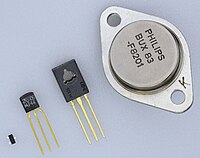
Photo from wikipedia
Metal halide perovskites are an important class of emerging semiconductors. Their charge carrier dynamics is poorly understood due to limited knowledge of defect physics and charge carrier recombination mechanisms. Nevertheless,… Click to show full abstract
Metal halide perovskites are an important class of emerging semiconductors. Their charge carrier dynamics is poorly understood due to limited knowledge of defect physics and charge carrier recombination mechanisms. Nevertheless, classical ABC and Shockley-Read-Hall (SRH) models are ubiquitously applied to perovskites without considering their validity. Herein, an advanced technique mapping photoluminescence quantum yield (PLQY) as a function of both the excitation pulse energy and repetition frequency is developed and employed to examine the validity of these models. While ABC and SRH fail to explain the charge dynamics in a broad range of conditions, the addition of Auger recombination and trapping to the SRH model enables a quantitative fitting of PLQY maps and low-power PL decay kinetics, and extracting trap concentrations and efficacies. However, PL kinetics at high power are too fast and cannot be explained. The proposed PLQY mapping technique is ideal for a comprehensive testing of theories and applicable to any semiconductor.
Journal Title: Nature Communications
Year Published: 2021
Link to full text (if available)
Share on Social Media: Sign Up to like & get
recommendations!